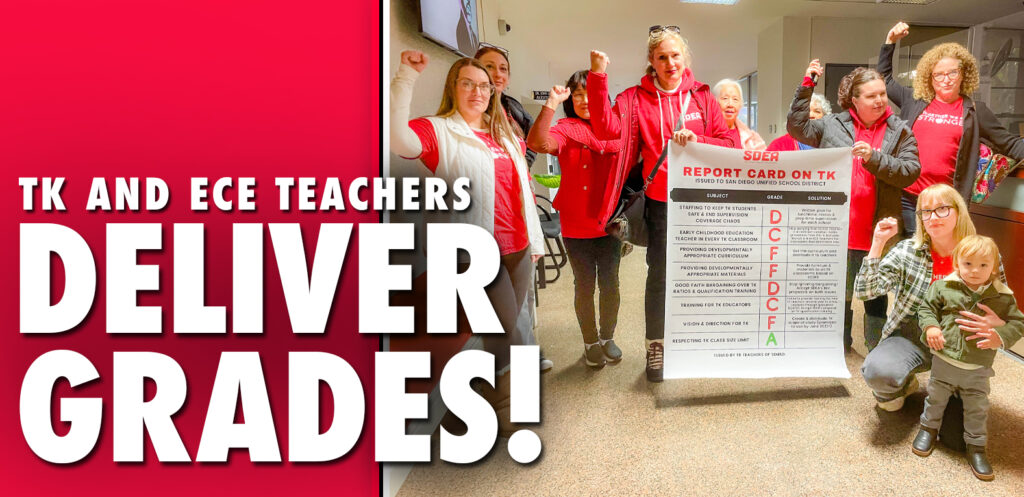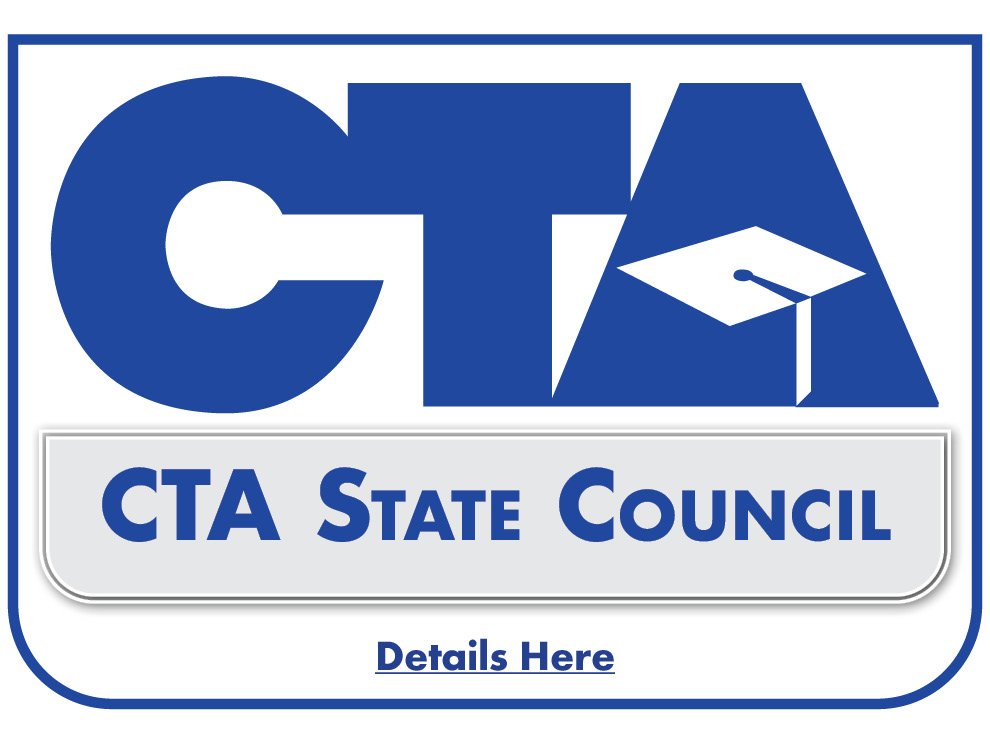The Millions of Reasons Why SDUSD Layoffs Are Unnecessary

Educators strongly oppose the San Diego Unified School District's (SDUSD) plan to lay off teachers. While there is a need for some staffing adjustments, due to declining enrollment, these district layoffs are not the most effective solution. A recent review of the District budget shows millions of dollars in reserves, less than anticipated spending on salaries, and bloated budgets for books and supplies. These sources are more than sufficient to avoid the layoffs currently contemplated by the District.
Layoffs Counterproductive Amidst Teacher Shortage
The current critical teacher shortage makes it such that we need to hold on to all teachers, while smartly navigating the need to cut staffing. The preliminary layoffs would send a negative message about SDUSD as an employer which could deter potential hires and exacerbate the existing staffing challenges—especially in areas like special education.
Attrition-Based Staffing Adjustments is the Way to Go
An alternative approach that relies on attrition, the natural reduction in staff through retirement, resignation, or other factors is the only reasonable path to avoiding layoffs, By not filling vacated positions, SDUSD could achieve necessary staffing adjustments without resorting to layoffs. This approach also includes utilizing existing reserves or designated budget allocations to address any unforeseen staffing needs.
Our Important Wage Increases Are Not Causing These Layoffs
This year, the full 15% wage increase secured through our union contract will be fully implemented. These wage increases were crucial to attracting and retaining top talent, thereby ensuring a strong foundation for our students' success.
Here's the good news: despite these well-deserved pay raises, a recent review of the District's budget shows that the SDUSD is currently projected to spend less on teacher salaries than originally budgeted for at the start of the year, even after accounting for the 15% raise!
SDEA Urges SDUSD to Utilize Existing Resources
Other identified areas where SDUSD could find resources to avoid layoffs. These include:
- Unrestricted Reserves: The District's growing unrestricted reserves, which are projected to reach $67.5 million by the end of this year, are more than sufficient to avoid layoffs.
- Scrutinizing Restricted Sources: SDUSD must explore all options within restricted funding sources to further mitigate the need for layoffs. At current projections, the District is slated to end the school year with over $315 million in restricted balances. While the term connotes these monies are restricted for specific uses, it’s imperative for SDUSD to go through its restricted budget with a fine-tooth comb and find solutions to avoid these layoffs.
- Optimizing Budget Allocations: SDUSD is showing a significant increase in spending on Books & Supplies, suggesting these funds could be redirected to avoid layoffs.
A World Without Layoffs Is Possible
San Diego Unified School District should prioritize retaining its valued educators through attrition-based staffing adjustments rather than resorting to layoffs. This not only avoids sending a negative message to potential hires but also helps maintain the strong foundation our schools need for student success. We urge the SDUSD to utilize existing resources, such as unrestricted reserves, scrutinize restricted funds, and optimize budget allocations, to ensure a future where our schools are not only well-staffed but also equipped to offer the best possible education for all.
Letters in Solidarity: Let’s Finish What We Started

Last year, SDEA members won big improvements to our contract. This happened because of our solidarity. When we stand together, we win. We are not done winning. This year’s reopener is another opportunity to achieve major improvements to our contract.

- Evaluations- Educators need an evaluation system that is meaningful, but not labor intensive. Evaluations that take time away from teacher planning time have a negative impact on our students.
- Fall Excessing- Fall excessing disrespects teachers and students, and destabilizes schools. The district needs to use its resources to staff schools before school starts.
- Wages- We won a historic raise last year. SDEA members are now the top in the county with our combined wages and benefits, but we must remain vigilant to stay there.
- Housing- Lack of affordable housing impacts our members in many ways. It is the reason that we are experiencing declining enrollment. Declining enrollment results in a reduction in educator jobs. Housing prices also deter new educators from working in San Diego. Even with our 15% raise, new educator salaries are not sufficient for educators to live in the communities in which they work which results in vacancies in critical areas.

In January, 80% of schools participated in bargaining input sessions at their site meetings. The meetings included participating in a survey to gather member’s positions on Evaluations, Fall Excessing, Wages and Housing. The data was used by our bargaining team to inform our bargaining platform.

- 62% of members prefer the traditional percentage wage increase.
- 65% strongly agree that fall excessing should be eliminated.
- 14% agreed that the workload associated with E3 is equal or less than the traditional evaluation.
- 15% agreed that the E3 evaluation was meaningful.

- The projected increase in funding for K-12 schools is 0.76% compared to over 13% in previous years.
- Federal COVID recovery funds are set to expire at the end of this school year.
- Declining enrollment will further reduce incoming funds.

The SDEA bargaining team, composed of 13 members and chaired by Stacy Hernandez, site union leader from Dailard Elementary, will meet with the district to fight for the improvements members want in our contract.

We can all support the bargaining team by wearing red on bargaining days. The next two bargaining sessions are on March 21 and April 18.

SDEA Endorsements Primary Election Round Up

Election results are unofficial and will be certified on or before April 4th. However, these are the results for the SDEA endorsed candidates as of election day. Any changes to these presumed results will be updated and shared.
Sabrina Bazzo, the SDEA endorsed incumbent, defeated challenger Crystal Trull in the race for sub-district A on the SDUSD School Board. The SDEA PAC campaign included a series of direct mailers to residents in the sub-district in support of Bazzo. Additionally, our labor allies from the SD Building Trades Council organized a neighborhood canvas to aid in the reelection efforts of Sabrina as a governing board member. Neither Richard Barrera or Sharon Whitehurst-Payne faced a challenger in the primary campaign and will move onto the general election unopposed. The SDEA campaign to reelect Sabrina will continue in the fall. Member participation in our political efforts will be essential to ensure success.

In the San Diego City Council races, SDEA endorsed candidate Sean-Elo Rivera, representing District 9, had an impressive election day win and will move on to the general election. Marni Von-Wilpert in District 5 did not have a primary challenger and was re-elected to her council seat. In a tight race, it appears that Coleen Cusack will advance to the general election for the District 3 council seat.

To help ensure we maintain a pro-educator and pro-public education majority on the school board, SDEA continues our PAC Drive to help fund electoral campaigns for our endorsed candidates. To be successful in this crucial work of our union, we need you to help provide the necessary funding for these political campaigns. Please give now using this PAC Drive link. We thank you in advance for your support!
Letters in Solidarity: Bargaining to Address the Needs of the Whole Child

Big shout out to our SDEA school counselor colleagues who we honor during National School Counseling Week! Let’s uplift our school counselors who provide students with invaluable academic, career, social, and emotional support each day. We're grateful for the work our school counselor colleagues do to help all our students learn, grow, and achieve their dreams!
We are proud that, together with our fellow union educators that mobilized throughout the district during last year’s successful contract campaign, we were able to win significant increases to elementary counselor allocations that have doubled or tripled the number of days for counselors at many schools. Our students’ behavioral and mental health needs have grown since the beginning of the pandemic and counselors are an essential part of the wrap-around supports that take into account the whole child.
When considering what our students need outside the classroom in order to be successful inside the classroom, housing insecurity is a major factor that negatively impacts student well-being. With the rising cost of living in San Diego, the number of families experiencing housing insecurity is steadily increasing. This is especially concerning for our students and their families as increasing housing costs are a stressor and lead to increased homelessness. Housing insecurity has a major influence on children’s healthy growth and development and is linked to negative mental and physical health outcomes, lower test scores, poor attendance, and lower future educational attainment.
In San Diego County, 93% of extremely low-income households with young children are housing insecure, paying more than half their income on housing costs. More than 8,000 SDUSD students are experiencing homelessness and many SDUSD families have tragically been displaced by the recent flooding during the January storm.
Addressing the housing crisis in San Diego requires urgent action from all levels of government and that starts with our school district. Currently, San Diego Unified provides resources specifically targeted to help homeless students in accordance with the McKinney-Vento Homeless Assistance Act with support from the County Office of Education. These supports include school site liaisons that assist unhoused, foster, and military students and their families in connecting to resources such as bus/transit passes, supplies (clothing, school supplies, hygiene products), and homelessness programs.
We will return to the bargaining table later this month to negotiate with the district as part of our reopener mid-contract discussions on 4 key areas: wages for next school year, transfers including eliminating fall excessing, evaluations and housing. Our bargaining related to housing will structure employee workforce housing that SDUSD is building with bond funds as well as housing supports for students and their families who are experiencing homelessness or housing insecurity. Just as we did last year during our successful contract campaign, we have the opportunity to join local organizations and SDUSD families in advocating for the schools AND communities that our students deserve.

Know Your Rights! Excessing

What is excessing?
"Excessing" is a type of involuntary transfer to achieve a reduction of staff due to declining enrollment or loss of funding at the site or in a program. It is also used in the event a site's SGT changes its instructional program and there is a need for certain types of credentials, such as converting to a bilingual or dual immersion program, which may result in losing employees who do not have the proper credentials. Central office staff are usually excessed due to funding cuts or program closures. The term in the union contract is “transfer to reduce staff,” and "involuntary transfer."
Being excessed is not the same as being laid off. A member who is transferred to reduce staff (“excessed”) will still have a job in SDUSD in the subsequent school year, but the location of the job will change. On the other hand, a layoff notice means that the member might not have a job in SDUSD in the next school year.
Note that these rules below are somewhat different for itinerant staff (School Psychs, SLP's, Nurses, some VAPA teachers, some Specialized Service Providers in SpEd, and most central office staff) and for multiple assignment staff (some School Counselors, Prep Time and Enrichment teachers, some SpEd staff), who operate under different sections of the contract when it comes to excessing and future assignments (see Sections 12.12, 12.13, and 12.14). For the vast majority of site-based staff, however, these rules apply.
The window for excessing only opens twice a year, although SDEA and SDUSD's bargaining teams are working to end the practice of Fall excessing right now. Transfers to reduce staff (“excessing”) can only happen at the end of one school year for the next school year, with written notification from HR required to excessed staff three days prior to the start of the spring Post & Bid. This notification explains excessed employee rights and the post and bid procedure, and usually comes a month prior to post and bid going live. This process usually begins with Site-Based Budgets (SBB's) in January, and excessed staff are usually notified verbally via their direct superior that they will be excessed, by February. Currently, excessing can also happen after the early fall student enrollment count, but no later than October 31; but this process may change pending the outcome of current negotiations.
Excessing is based on seniority.
Instead of allowing the supervisor to play favorites, the union contract establishes rules about who is to be transferred should there be a need to involuntarily transfer staff (“excess”). This is accomplished by looking at district seniority of the employees in the subject area or program that needs a staff reduction and administration selecting the one with the lowest district seniority (there is no such thing as a "site seniority"). In the event that there is a tie in seniority dates, the contract does not address what is to be done. In these very rare cases, the person selected for excess is accomplished via lot (coin toss, draw straws, etc.).
Indispensable Services
There is a small exception to the seniority process established in the contract, where less senior employees who are in one of the "indispensable services" categories may be retained, while a more senior employee gets excessed. This is most commonly used to retain less senior employees who hold a special credential that no one else on site holds, that is necessary for the instructional program (bilingual credentials are the most common), or those employees with an extended day assignment at a high school (such as ASB advisor or a coaching assignment).
SDEA has lost an arbitration trying to argue that members in extended day assignments could or should get excessed in seniority order, if there are volunteers, or others more senior at the site, willing to take the extended day assignment, including the more senior employee slated to be excessed. Unfortunately, the arbitrator did not see it that way. They ruled that if one holds an extended day assignment, the administration can choose to skip them for excessing and excess the next most senior employee in the subject area or program at the site. Currently, there is no ability to make the grievance argument that in order to prevent a more senior employee from being excessed, when a less senior one is retained due to an extended day assignment, the more senior employee could or should be given the assignment.
Steps in the Excessing Process
Here are the steps that need to be followed when administration needs to excess staff. The supervisor determines, based on enrollment (or funding cuts in central office programs), the subject area or program at the site to be reduced. As of Spring 2023, elementary sites no longer reduce staff based on grade "levels" (TK - 3 or 4 - 6), but across the entire site, based on seniority. For elementary sites, the "program" is the UTK - 6th grade, so excessing is done in seniority order from among the entire staff at the site. The supervisor must ask for volunteers to achieve the desired reduction in staff. If there is no volunteer, the member with the least seniority at the site in the subject area, or in the affected program is to be transferred ("excessed").
In some cases, the member to be transferred may be able to exercise seniority rights to stay at the site. To exercise seniority rights, the member must meet two requirements:
- The employee slated for excess must be more senior than another member who works in a different subject area or program at the site in which they wish to exercise seniority rights.
- The employee slated for excess must have recent experience in that subject area or program at the site. This means they have taught in SDUSD in that different subject area or program for at least one school year in the last five, or two school years in the last nine.
Only the member who is slated for excess can decide if they want to exercise these seniority rights to stay, if they are eligible. The supervisor can’t exercise seniority rights for them.
Post & Bid
Once a person is slated for excess, they then have to participate in the post and bid process in late April or early May to secure a position for next year, or they are placed by HR if they do not. In some cases, someone quits or retires from a school site where someone was excessed, or transfers to another site or assignment, prior to the post and bid going live. In these cases, the need for excessing may be resolved via attrition, meaning the person who was excessed is placed back at the site by HR due to a position being vacated that they have a credential for by another employee leaving.
On the post and bid, excessed employees have special rights to positions, have a secondary staffing process if they do not secure a position via the post and bid, and have a guarantee that HR will place them into a position they are qualified and credentialed for if they do not get a position via either of these two processes, or do not participate in them.
Priority Consideration
Anyone who is excessed gets a status known as "priority consideration" on the post and bid. This means that at school sites where seniority and priority consideration are factors used to route applicants to those sites for interviews and consideration for their vacancies, excessed staff with priority are guaranteed an interview. At most school sites, this means that the top six most senior applicants with priority (excessed staff), and the top six most senior applicants without priority (voluntary bidders) are routed to school sites for selection. Applicants with priority are guaranteed an interview. Sites then must choose their preferred applicant from this group of 12 routed applicants. If the site does not pick one, then HR assigns the most senior applicant to the site. Magnet schools, "low performing" schools (based on the CA Dashboard status of the site, as determined by the joint SDEA/SDUSD Contract Administration Committee), and schools with high teacher turnover and high numbers of probationary status teachers, are exempt from using seniority or priority consideration status as factors in selecting who they want to staff their vacancies. They pick their preferred candidate from the list of all eligible applicants that are routed to them by HR. Employees picked by a site are notified in writing if they have been accepted by a school site, and they have 48 hours, or other mutually agreed upon time frame, to accept or deny the position.
After Post & Bid
If an excessed employee is not picked up by a site via the post and bid, there is a staffing process, limited to excessed employees only, after the post and bid. In essence, HR sends a list of all remaining and new vacancies available after the post and bid, via email, to all remaining excessed employees. Those excessed employees then rank their preferences electronically (usually done via Google Forms). Then, after the ranking is done, HR assigns positions in seniority order. Those who still do not secure a position via this process, are then assigned by HR, although this is extremely rare. Once an assignment is made via either of these processes, employees do not have the option to reject it.
In fall, if an excessed employee's former site has a vacancy that was created, either through attrition or enrollment growth, the excessed employee can request to return to their former site. It is not a guarantee that the excessed employee gets to return, however. In order for HR to facilitate this, their internal process requires the administrator at the new school site and the administrator at the old site agreeing to release and accept the excessed employee, and then HR moves them.
What should we do if our rights aren't respected?
Talk with the AR (Association Representative) at your worksite, and read the applicable contract sections (all found in Article 12). Our union contract has a process for enforcing our rights — the grievance procedure (see Section 12.15 and Article 15). The next step you and your AR might take is an informal grievance meeting with the supervisor to address the violation and give them a chance to correct their mistake.
TK and ECE Teachers Deliver Grades!

Universal Transitional Kindergarten is the newest grade level in SDUSD. It brings children as young as 3 years old to our campuses.In 2021 Gavin Newsom signed Assembly Bill 130 to gradually expand TK over a 4 year period. SDUSD became early implementers of AB 130, meaning there would be no gradual expansion and all students 4 years old by September 1 would be included. While there are many positives to being early implementers, including over 200 highly qualified ECE Teachers joining our ranks, there were many unresolved issues.
Last year TK and ECE Teachers held a listening session at SDEA with district leadership to address those issues. The issues were defined and solutions were agreed upon, but there was inconsistent movement by the district. In December, ECE and TK Teachers held a union meeting to grade the district’s progress. With the exception of maintaining class size, the grades were not good. Then on January 9th, a group of ECE and TK Teachers delivered the report card to district leadership at the board meeting. Nobody wants a bad report card and the district leaders are no exception. The delivery of the report card prompted action by the district and triggered movement on many of the unresolved issues.
TK and ECE Teachers are dedicated to providing a high quality TK experience for their students. We will continue to hold the district accountable to provide a program our students deserve. Together We Are Stronger!

2024 Spring SDEA Online Election

SDEA is a member-run democratic organization which means YOU have the opportunity to be involved and run for a leadership position! Spring election nominations are now open for a variety of roles:
Be an influential voice and have a direct impact on thousands of your fellow union members by completing your nomination form(s) today! View the election timeline, complete and submit the necessary documents to the SDEA Election Committee at sdeaelections@sdea.net by 5pm on Monday, March 4th.
Letters in Solidarity: SDEA Signs On to US Labor Movement Call for Ceasefire in Israel and Palestine

In this month when we honor the impact of Dr. Martin Luther King Jr. and the Civil Rights Movement, it is important to highlight the critical role of unions in standing up for the rights of historically marginalized groups of people, especially when it was not easy or comfortable to do so. The Brotherhood of Sleeping Car Porters was the first predominately African-American union and leaders like E.D. Nixon and A. Phillip Randolph were instrumental to the success of the Montgomery Bus Boycott in 1955 and the March on Washington in 1963. When MLK was jailed in Birmingham for participating in non-violent civil disobedience that was met with violent repression by police, he wrote a letter to fellow religious leaders about the common humanity of all people and said “Injustice anywhere is a threat to justice everywhere.”
This message was a guiding principle for the SDEA Board of Directors and SDEA Representative Council as we reflected on our role as educators and a union in relation to the crisis in Israel and Palestine. After thoughtful and respectful discussions, we voted to join other unions in signing on to the US Labor Movement’s Call for Ceasefire in Israel and Palestine.
The heartbreaking loss of life and the ongoing conflict and trauma for the people of Palestine and Israel are beyond comprehension. We believe that everyone deserves to live in peace. To be able to work and find sanctuary and joy in our communities and homes. To send our children to school. To see our children grow. With sincerity and open hearts, we add our voices to the many who have called for a ceasefire in Gaza and the release of all hostages.
We will now engage our state union, California Teachers Association, and our national union, National Education Association, on how to use our collective influence to move the United States government to implement the demands in the statement.
The process that we engaged in as a union when deciding to sign on to this statement is consistent with our classroom environments that uplift our students’ shared humanity enriched by their diverse life experiences and perspectives. It is important that we continue cultivating spaces for dialogue where we enter with open minds and seek to find common ground. This strengthens our union’s democracy and generates the unity and power that we need to win the schools our students deserve. As SDEA elected leaders, we are proud of our union’s ability to deliberate and take action regarding the crisis in Israel and Palestine in a way that builds our solidarity and our educator movement.

K-12 BUDGET UNDER PRESSURE: Gov. Newsom Proposes Negligible Growth in K-12 Funding for 2024-2025, State Rainy Day Funds Utilized

In the upcoming fiscal year, California faces a daunting $40 billion deficit for 2024-2025, as revealed in Governor Newsom's recent budget proposal. Despite the overall budgetary challenges, Newsom suggests a minimal 0.76% Cost of Living Adjustment (COLA) increase in the state’s K-12 funding, primarily funded by tapping into the state's rainy day funds. Without this intervention, a direct decrease in funding would have been inevitable.
The overwhelming majority of the funding for the district is derived from state sources. So the fact that the uptick in schools funding from the state is a meager 0.76% will have wide ranging impacts. The proposed COLA falls far short of the previously anticipated 4% increase. However, considering the enrollment decline in districts like San Diego Unified, and the middling attendance levels, the state's 0.76% COLA may actually result in a slight reduction in actual state funding for San Diego Unified on a year-over-year basis-- a situation unseen since the Great Recession.
So, what does all this budget information mean for you as an educator in the San Diego Unified School District? The District will likely make changes or cuts to certain programs to balance their budget. Something that has already been seen at the central office. The main goal is always to avoid cutting resources and services from school sites. The good news is that SDUSD has money set aside in its budget reserves that it can use to support important school programs, and it should use those reserves.
Additionally, we are entering into reopener negotiations with the SDUSD again. These negotiations will include discussions about wages. While reopener bargaining will start soon, in February, negotiations about wages may not begin until May when we expect the governor to revise the budget. The hope is that the state's financial situation will improve, allowing for meaningful salary discussions after the May Revised Budget. It's important to note that even though the governor revises the budget in May, the final budget becomes a law that needs approval from the legislature by June 30th. The hope is that negotiations between those in power in Sacramento in the coming months will result in more funding for districts like SDUSD.
SDEA Political Action Committee Update: Politics in Action!

The SDEA Political Action Committee (PAC) has been busy preparing for the political season. We recently interviewed candidates for the San Diego City Council and recommended endorsing Coleen Cusack for District 3, Marni Von-Wilpert for District 5, and Sean Elo-Rivera for District 9. All endorsement recommendations were approved by the democratically elected SDEA Board and the Representative Council.

SDEA-endorsed SDUSD School Board Members Sabrina Bazzo, Richard Barrera, and Dr. Sharon Whitehurst-Payne are all up for reelection in 2024. SDEA leaders were instrumental in helping gather member signatures in order for our endorsed candidates to qualify for the ballot. Sabrina Bazzo is the only trustee to face a challenger in the March 5 primary election for the District A school board seat. This year, the general election for this seat will be by sub-district only for the first time, versus an election by voters throughout the entire school district.
To help ensure we maintain a pro-educator and pro-public education majority on the school board, SDEA is launching a PAC Drive to help fund electoral campaigns for our endorsed candidates. All members are highly encouraged to donate to the SDEA PAC to prevent the rise of fringe groups from taking hold in our school district. Last election cycle, we saw anti-union forces spending hundreds of thousands of dollars to try and establish a political presence in SDUSD. Due to the hard work of the SDEA PAC, your union was able to push back and secure victory at the ballot boxes. Victories like these are only possible through contributions from members like you! To be successful in this crucial political work of our union, we need you to help provide the necessary funding. Please give now using this PAC Drive link. We thank you in advance for your support!













